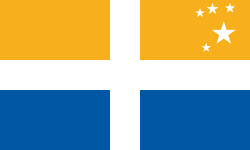Isles of Scilly
The Isles of Scilly form an archipelago off the southwestern tip of the Cornish peninsula of Great Britain.
| Geography | |
|---|---|
| Location | Atlantic Ocean, 45 km (28 mi) off the coast of Cornwall, England |
| Coordinates | 49°56′10″N 6°19′22″W / 49.93611°N 6.32278°WCoordinates: 49°56′10″N 6°19′22″W / 49.93611°N 6.32278°W |
| Area | 16.03 km2 (6.19 sq mi) |
| Country | |
United Kingdom | |
| Demographics | |
| Population | (Ranked ) |
The islands have had a unitary authority council since 1890, and are separate from the Cornwall unitary authority. Some services are combined with Cornwall and the islands are still part of the ceremonial county of Cornwall.
The islands are designated an 'Area of Outstanding Natural Beauty'. They have been dangerous for ships, and there are 530 known shipwrecks around the archipelago.[1]
Ancient history
Scilly has been inhabited since the Neolithic. Its history has been one of subsistence living until the early 20th century (people lived from what they could get from the land or the sea). Farming and fishing continue today, but the main industry now is tourism.
It is likely that until relatively recent times the Isles were much larger with many of them joined into one island, named Ennor. Rising sea levels flooded the central plain around 400–500 AD, forming the current islands.[2]
Evidence for the older large island includes:
- A description in Roman times describes Scilly as "Scillonia insula" in the singular, as if there were a single island or an island much bigger than any of the others.
- Remains of a prehistoric farm have been found on Nornour, which is now a small rocky skerry far too small for farming.[3]
- At certain low tides the sea becomes shallow enough for people to walk between some of the islands. This is possibly one of the sources for stories of drowned lands, e.g. Lyonesse.
- Ancient field walls are visible below the high tide line off some of the islands (e.g. Samson).
- Some of the Cornish language place names also appear to reflect past shorelines, and former land areas.[4]
- The whole of southern England has been steadily sinking in opposition to post-glacial rebound in Scotland.
Offshore, midway between Land's End and the Isles of Scilly, is the supposed location of the mythical lost land of Lyonesse, referred to in Arthurian literature.
Scilly has been identified as the place of exile of two heretical 4th century bishops, Instantius and Tiberianus, who were followers of Priscillian.[5]
Geography
The Isles of Scilly form an archipelago of five populated islands and many other small rocky islets (around 140 in total) lying 45 km (28 mi) off Land's End. They are all composed of granite of early Permian age.
The position of the islands causes great contrasts. The warming effect of the sea means they rarely have frost or snow. This allows local farmers to grow flowers earlier than would grow on mainland Britain. The chief agricultural product is cut flowers, mostly daffodils.
Exposure to Atlantic winds means that spectacular winter gales lash the islands from time to time. This is reflected in the landscape. On Tresco, the lush sub-tropical Tresco Abbey Gardens shelter on the southern end of the island, but the low heather and bare rock get the wind on the exposed northern end.
Isles Of Scilly Media
Olaf Tryggvason, who visited the islands in 986. It is said an encounter with a cleric there led him to Christianise Norway.
Scilly was one of the Hundreds of Cornwall (formerly known as Cornish Shires) in the early 19th century.
The five wards (which are also the civil parishes) of the Isles of Scilly; red is St Agnes, blue is Bryher, orange is Tresco, green is St Martin's, and grey is St Mary's.
References
| Wikimedia Commons has media related to Lua error in Module:Commons_link at line 62: attempt to index field 'wikibase' (a nil value).. |
- ↑ "The Isles of Scilly - Shipwrecks and Valhalla". cornwallinfocus.co.uk. 2011. Archived from the original on 9 August 2010. Retrieved 17 June 2011.
- ↑ "Ancient sites on the Isles of Scilly". Cornwall in focus. Archived from the original on 16 May 2011. Retrieved 15 October 2008.
- ↑ Dudley, Dorothy. "Excavations on Nor'Nour in the Isles of Scilly, 1962-6", in The Archaeological Journal, CXXIV, 1967 (includes the description of over 250 Roman fibulae found at the site)
- ↑ Weatherhill, Craig (2007) Cornish placenames and language. Wilmslow: Sigma Leisure.
- ↑ "Priscillianus and Priscillianism". Dictionary of Christian biography and literature to the end of sixth century. Retrieved 11 December 2010.











